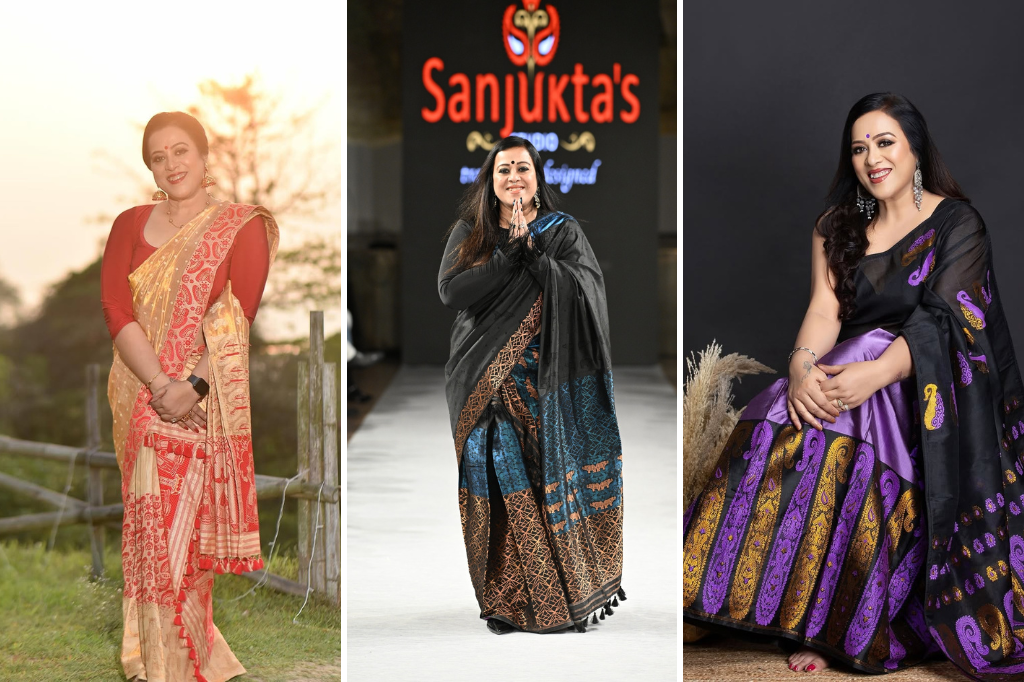🧵 In a world racing toward fast fashion and faster obsolescence, few pause to look back — to listen to the quiet hum of the handloom that once clothed civilizations. Yet in the heart of Assam, designer Sanjukta Dutta has done exactly that. She’s not just designing garments; she’s designing revival.
Her latest work is more than a fashion collection — it’s a cultural statement. Dutta is using actual handwoven Assamese fabrics — not mill-made replicas, not “inspired” prints — but real, loom-born textiles created by local artisans. From mekhela chadors to reinterpretations in contemporary silhouettes, her creations carry the tactile poetry of tradition while speaking fluently in the modern design language the global audience understands.
This fusion of heritage + relevance is where revival truly begins. Because let’s be honest — preservation without participation is just nostalgia.
🌿 Beyond Fabric: A Story of Identity and Dignity
What Sanjukta is doing in Assam is not charity work. It’s collaborative empowerment. Each thread she uses carries the story of a weaver — mostly women — whose skills were fading into economic obscurity. By integrating their craft into high-fashion platforms, she’s doing something no “revival policy” or government scheme has managed to achieve effectively: she’s giving artisans an audience, not an allowance.
Every motif from the Assamese looms — the Jaapi, the Gamosa, the Phoolam Buta — reflects the regional identity. But under Dutta’s vision, these motifs are reborn into global silhouettes: wrap gowns, jackets, fusion drapes — pieces that can walk the ramp in Paris or the streets of Guwahati with equal grace.
It’s a reminder that handloom isn’t meant to be frozen in museums or framed as “village art.” It’s living art. It breathes when worn.
🤝 The Collaboration Template India Needs
At Save Handloom Foundation, this is the kind of partnership model we’ve been advocating — the weaver-designer collaboration that doesn’t just buy fabric, but builds ecosystems.
Dutta’s initiative shows how this can be done right:
- Authenticity first: Using locally woven, natural-fibre fabrics — not synthetic blends masquerading as “ethnic.”
- Cultural continuity: Retaining Assamese motifs and weaving techniques instead of diluting them for convenience.
- Modern appeal: Translating heritage into silhouettes that fit today’s lifestyle.
- Economic dignity: Structuring the collaboration so artisans earn fairly, sustainably, and continuously.
This is the bridge between DesiFusions.com’s mission — to blend natural fibres, tradition, and contemporary design — and the future of ethical fashion in India.
🌏 The Global Stage Is Watching
Assam has long been one of India’s most underrepresented textile regions, often overshadowed by Banaras, Kanchipuram, or Bengal. But thanks to stories like Sanjukta Dutta’s, that’s changing.
She’s taking Assam’s handloom to international platforms — not as a token cultural exhibit, but as a competitive design identity. That’s the real breakthrough: when a traditional fabric stops being “ethnic wear” and starts being everywhere wear.
When the world sees Assamese weaves not as exotic, but as essential — that’s when revival becomes revolution.
⚡ Final Thought
India’s handloom revival won’t happen in conference halls or policy papers — it will happen on looms, in workshops, and in collaborations like these.
Designers like Sanjukta Dutta aren’t just making clothes; they’re making culture wearable again.
At Save Handloom Foundation, we believe that’s the blueprint for India’s textile future — rooted in tradition, yet reaching for tomorrow.
Because the loom doesn’t just weave fabric. It weaves identity.
And the revival of handloom isn’t just about saving a craft — it’s about saving ourselves from forgetting who we are.

